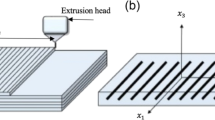Abstract
One of the primary barriers for adoption of additive manufacturing (AM) has been the uncertainty in the performance of AM parts due to residual stresses/strains. The rapid heating and cooling rates from the thermal history of the laser melting process result in high residual stresses/strains that produce significant part distortion. Efforts to mitigate residual stresses using post-process heat treatments can significantly impact the microstructures of the AM part which may lead to further issues. Therefore, the ability to accurately predict the residual stresses in as-built AM parts is crucial, and rigorous benchmark measurements are needed to validate such predictions. To fill this need, the AM-Bench aims to provide high-fidelity residual stress and strain benchmark measurements in well-characterized AM bridge-shaped parts. The measurements reported here are part of the residual elastic strain benchmark challenge CHAL-AMB2018-01-RS. Residual strains and stresses in this work were measured using neutron diffraction, synchrotron X-ray diffraction, and the contour method. Part deflection measurements were performed using a coordinate measurement machine after the part was partially separated from the build plate. These independently measured results show a high degree of agreement between the different techniques.




















Similar content being viewed by others
Notes
Mention of commercial products does not imply endorsement by the National Institute of Standards and Technology, nor does it imply that such products or services are necessarily the best available for the purpose.
References
Li C et al (2018) Residual stress in metal additive manufacturing. Procedia CIRP 71:348–353
Nadammal N et al (2017) Effect of hatch length on the development of microstructure, texture and residual stresses in selective laser melted superalloy Inconel 718. Mater Des 134:139–150
Robinson J et al (2018) Determination of the effect of scan strategy on residual stress in laser powder bed fusion additive manufacturing. Addit Manuf 23:13–24
Robinson JH et al (2018) The effect of hatch angle rotation on parts manufactured using selective laser melting. Rapid Prototyp J 25:289–298
Strantza M et al (2019) Directional and oscillating residual stress on the mesoscale in additively manufactured Ti-6Al-4 V. Acta Materialia 168:299–308
Levine LE et al (2019) Outcome and conclusions from the 2018 AM-bench measurements, challenge problems, modeling submissions, and conference. Integr Mater Manuf Innov (topical collection from the AM-bench 2018 test series)
Lass EA et al (2017) Formation of the Ni3Nb δ-phase in stress-relieved inconel 625 produced via laser powder-bed fusion additive manufacturing. Metall Mater Trans 48(11):5547–5558
Gnäupel-Herold T, Slotwinski J, Moylan S (2014) Neutron measurements of stresses in a test artifact produced by laser-based additive manufacturing. AIP Conf Proc 1581(1):1205–1212
Wang Z et al (2016) Diffraction and single-crystal elastic constants of Inconel 625 at room and elevated temperatures determined by neutron diffraction. Mater Sci Eng A 674:406–412
Gnäupel-Herold T (2012) ISODEC: software for calculating diffraction elastic constants. J Appl Crystallogr 45(3):573–574
Croft M et al (2002) Strain field and scattered intensity profiling with energy dispersive x-ray scattering. J Appl Phys 92(1):578–586
Croft M et al (2005) Strain profiling of fatigue crack overload effects using energy dispersive X-ray diffraction. Int J Fatigue 27(10):1408–1419
Tsakalakos T et al (2006) Measurement of residual stress distributions by energy dispersive X-ray diffraction synchrotron radiation. In: The sixteenth international offshore and polar engineering conference. International Society of Offshore and Polar Engineers, San Francisco, California, USA, p. 8
Strantza M et al (2018) Coupled experimental and computational study of residual stresses in additively manufactured Ti-6Al-4 V components. Mater Lett 231:221–224
High-density tungsten based metals—Mi-Tech metals. Available from: https://www.mttm.com/tungsten-alloys. Accessed 15 Apr 2019
Clausen B (2014) SMARTSware manual. Los Alamos National Lab, Los Alamos, NM, LA-UR 04-6581
Larson AC, Dreele RBV (1986) GSAS manual. Los Alamos National Lab, Los Alamos, NM, LA-UR 86-748
Holden TM, Suzuki H, Carr DG (2006) Macroscopic stress measurements by neutron diffraction and the part played by the “stress-free” reference. ISIJ Int 46(7):959–965
Prime MB, DeWald AT (2013) The contour method. In: Schajer GS (ed) Practical residual stress measurement methods. Wiley, Hoboken, pp 109–138
INCONEL alloy 625—special metals. Available from http://www.specialmetals.com/assets/smc/documents/alloys/inconel/inconel-alloy-625.pdf. Accessed 15 Apr 2019
Mahmoudi AH, Saei A (2015) Influence of asymmetrical cuts in measuring residual stresses using contour method. Int J Press Vessels Pip 134:1–10
Olson MD, DeWald AT, Hill MR (2018) Validation of a contour method single-measurement uncertainty estimator. Exp Mech 58(5):767–781
Acknowledgements
Part of this research was supported by the Exascale Computing Project (17-SC-20-SC), a collaborative effort of the U.S. Department of Energy Office of Science and the National Nuclear Security Administration. Part of this work was performed under the auspices of the U.S. Department of Energy by Los Alamos National Laboratory, United States under Contract DE-AC52-06NA25396. Part of this work is based upon research conducted at the Cornell High Energy Synchrotron Source (CHESS) which is supported by the National Science Foundation under Award DMR-1332208. University of California, Davis, was supported by the Campus Executive program of Sandia National Laboratories.
Author information
Authors and Affiliations
Corresponding author
Ethics declarations
Conflict of interest
On behalf of all authors, the corresponding author states that there is no conflict of interest.
Rights and permissions
About this article
Cite this article
Phan, T.Q., Strantza, M., Hill, M.R. et al. Elastic Residual Strain and Stress Measurements and Corresponding Part Deflections of 3D Additive Manufacturing Builds of IN625 AM-Bench Artifacts Using Neutron Diffraction, Synchrotron X-Ray Diffraction, and Contour Method. Integr Mater Manuf Innov 8, 318–334 (2019). https://doi.org/10.1007/s40192-019-00149-0
Received:
Accepted:
Published:
Issue Date:
DOI: https://doi.org/10.1007/s40192-019-00149-0




